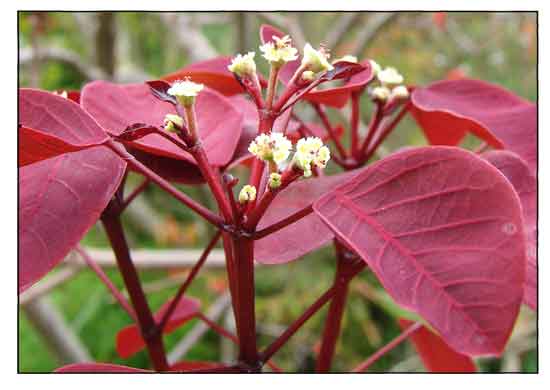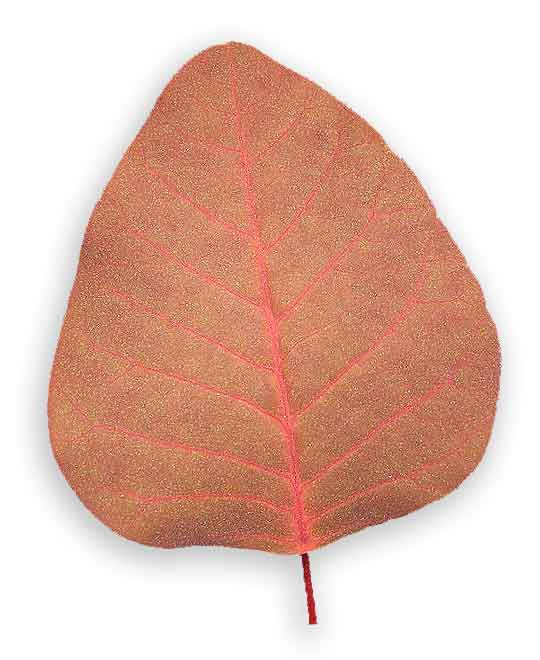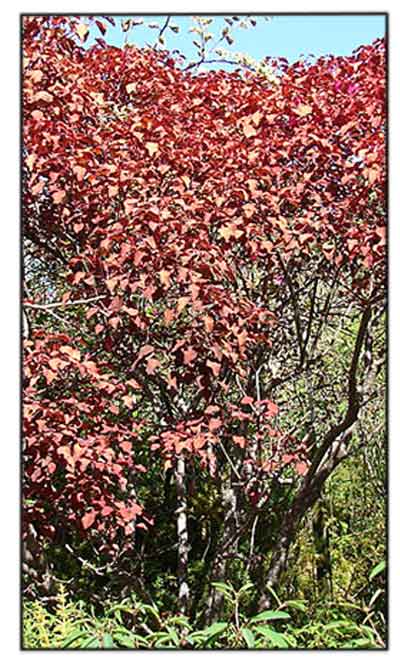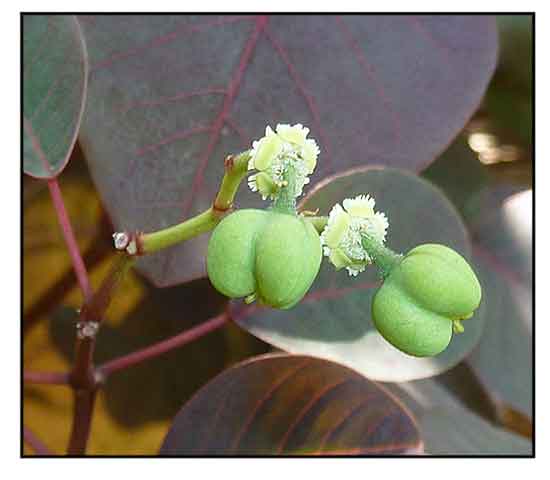 Gen info Gen info
- Euphorbia cotinifolia is a broadleaf red shrub native to Mexico and South America.
- Etymology: The genus name Euphorbia is derived from 'Euphorbus', the Greek physician to King Juba II, King of Mauretania, who was treated (probably) with Resin Spurge, which the king named Euphorbia resinifera after his physician Euphorbus. The specific epithet cotinifolia refers to its leaves, resembling Cotinus (smokebush), in this case red spurge, suggesting 'purge' or 'cleanse', referring to the purgative or laxative property of the sap of many herbaceous Euphorbia species. (6)
 Botany Botany
• An upright large shrub or small multi-stemmed tree, with stunning deep burgundy foliage. Foliage: Leaves simple, pinnately-veined, bright red venation distinct, margin entire, leaf blade ovate-rounded, apex acute, base obtuse-rounded, 3-whorled, 4 to 6 cm long, 3 to 4 cm wide, deep burgundy (with young leaves having brighter tones of red); petiole 3 to 6 cm long; stipules up to 0.3 mm long. Stem: Stems glabrous, deep burgundy, multi-branched. Flower:Cyathia (inflorescences consisting of cuplike clusters of bracts enclosing unisexual flowers) numerous, peduncle up to 2 cm long; bracts broadly cup-shaped, highly inconspicuous, lobes 4 to 6, triangular, pilose on margin; male flowers numerous, bracts linear; female flowers protruding from enveloping bracts. Fruit:Fruit capsules 3-angular-ovoid, smooth, sparsely pubescent to glabrous, up to 4mm in diameter; Seeds subglobose, brown, up to 3mm in diameter, foveolate (having tiny depressions on the surface). (6)
Distribution
- Introduced.
- Cultivated.
- Native range is Mexico to Tropical America.
 Constituents Constituents
- Study of leaves isolated new ingenol-esters as piscicidal constituents. The structures were established as 3-O-propionyl-20-O-(S)-(2′-methyl)butyryl-ingenol (1), 20-O-isobutyryl-ingenol (2), 3-O-propionyl-20-O-isobutyryl-ingenol (3), and 3, 20-O-di-isobutyryl-ingenol (4). (see study below) (4)
- Phytochemical screening of ethyl acetate extract and methanol extracts yielded flavonoids, terpenoids, tannins, steroids, glycosides, with absence of alkaloids, carbohydrates, proteins, and saponins. Petroleum and chloroform extracts yielded steroids, glycosides, and carbohydrates, with absence of alkaloids, flavonoids, terpenoids tannins, proteins and saponins. (3)
- Reverse-phase HPLC yielded polyphenolic compounds like catechin, vanillic acid, p-coumaric acid, rutin hydrate, and quercetin within the range of 80.14 ± 1.75, 3.09 ± 0.12, 1.22 ± 0.05, 27.09, ± 1.09 and 1.73 ± 0.03 mg/100 g extract, respectively. (see study below) (5)
- GC-MS study of leaf essential oil
yielded major constituents of ß-caryophyllene (39.3%), germacrene-D (21.5%) and α-copaene (9.3%). (7)
- Hydroalcoholic extract of stems revealed flavonoids, terpenoids, tannins, steroids, and phenols, with absence of alkaloids, carbohydrates, proteins, and saponins. (see study below) (10)
Properties
- Common names often refer to its its attractive burgundy-red foliage.
- Emetic and cathartic.
-
Latex is strongly purgative. (3)
- Studies have suggested antibacterial, piscicidal, antioxidant, antidiabetic, antihyperlipidemic, venom neutralizing, antifungal, cytotoxicity, antiviral properties.
- Caution: Poison and Irritant
- When broken, the purplish stems exude a sap that is a skin irritant.
- Latex in roots considered more poisonous than other parts of the plants.
- In humans, the sap can cause intense inflammation or blistering on skin contact, eye irritation and even temporary blindness. If ingested, it can cause organ damage.
- In Central America, the poisonous sap is used as both medicine and poison. (2)
- Eye protection and protective clothing advised when pruning.
Parts used
Leaves, stems, latex.
 Uses Uses
Edibility
- Caution: Fruits, roots, leaves reported as poisonous. (14)
Folkloric
- Reportedly used medicinally by indigenous inhabitants of Mt. Nebu, Bukidnon, Philippines.
-
In Central America, sap used as emetic and cathartic.
- Whole plants used for treatment of sores.
Used to cauterize wounds.
- In Tanzania, latex used for treatment of fungal infections of the nails.
(8)
- In Nigeria, used for treatment of venomous snake bites. (9)
Others
- Poison: Leaves yield a poisonous sap, which southern American Indians employed as poison for catching fish. (4) Also used as poison for arrowheads by the natives of Curacao. (2)
Studies
• Antibacterial / Leaves: Study evaluate the antibacterial activity of solvent extracts of E. cotinifolia leaves using agar cup diffusion and broth microdilution methods against common human pathogenic bacteria. The methanol extract subjected to silica gel column led to isolation of compound 1. Klebsiella pneumonia, Enterobacter aerogenes, and Bacillus subtilis were highly susceptible to the methanol extract with maximum inhibition zone of 19 mm. The MIC of compound 1 against human pathogens was 78-833 µg/ml. The moderate to potent antibacterial activity was attributed to the presence of phenols and flavonoids in the extracts. (3)
• Piscicidal / Leaves: Study of leaves isolated new ingenol-esters as piscicidal constituents. (see constituents above) (4)
• Antioxidant / Leaves: Study evaluated the antioxidant properties and HPLC profiling of polyphenolic contents of ethanol extract of E. cotinifolia leaves. Antioxidant activity by ABTS radical scavenging assay showed IC50 of 95.60 µg/ml, and maximum absorbance of reducing power of 0.0996 at 250 µg/ml. A relationship between polyphenolic compounds and antioxidant activity is suggested. (see constituents above) (5)
• Antifungal against Onychomycosis / Latex: Onychomycosis is a prevalent superficial fungal nail infection, which while not life-threatening can reduce a patient's quality of life. It is difficult to treat, and is associated with 20-25% treatment failure. Study evaluated the antifungal activity and brine shrimp lethality of latex, methanolic leaf and stem bark extracts. Extracts inhibited Trichophyton mentagrophytes and Aspergillus niger with inhibition zones of 17 and 15 mm, respectively, for leaves, and 9 mm for both fungi with stem bark extracts. The leaf extract also inhibited Trichophyton rubrum (12 mm), with MICs in range of 13.30 and 55.90 µg/ml (leaves) and 14.02 and 63.08 µg/ml (stem bark) compared to cyclophosphamide (16.36 and 61.02 µg/ml. (8)
• Venom Neutralizaton against Bitis arietans / Leaves: Study evaluated the neutralizing potential of E. cotinifolia leaf extract against Bitis arietans. Venom LD50 was greater than 5000 mg/kg. The venom neutralizing potential of the extract was not significant (p<0.05) when challenged with venom before the extract. Pretreatment with extract before the venom challenge showed statistically significant (p<0.05) neutralizing potency. The extract increased mean survival time and protection fold but could not protect the animals from death. Results suggest the ethanolic extract is orally safe in laboratory animals and possesses significant antivenom potential against Bitis arietans venom. (9)
• Antidiabetic/ Anti-Hyperlipidemic / Antioxidant / Stems: Study evaluated the antidiabetic, antihyperlipidemic, and antioxidant properties of hydroalcoholic extract of E. cotinifolia stems (300 and 600 mg/kbw) in streptozotocin-induced Wister rats. Glibenclamide was used as standard. Higher dose extract and glibenclamide significantly lowered blood glucose from 7th day, with glibenclamide showing to be more effective. Both extract doses and glibenclamide significantly reduced total cholesterol, LDL, and triglycerides, and significantly increased HDL cholesterol level. (10)
• Cytotoxic / Antiviral / Leaves and Stems: Study evaluated 47 plant extracts of 10 species of the genus Euphorbia used by Columbian traditional healers for in vitro antitumor (antiproliferative and cytotoxic) and antiherpetic activity. Five of the 47 extracts (11%) exhibited antiherpetic action; the highest activity was found in the leaf/stem of water-methanol extracts from E. cotinifolia and E. tirucalli. The therapeutic indexes of the two plants species were > 7.1. Six extracts (13%) from 4 plant species (40%) showed cytotoxic activity. The highest cytotoxicity was found in the dichloromethane extracts from E. cotinifolia leaves with CC50 values of 35.1 and 18.1 µg/ml for the most susceptible cell lines, Hep-2 and CHO, respectively. (11)
• Antioxidant / Anthocyanin / Leaves: Study evaluated the antioxidant activity and anthocyanin derivatives of extract of red katuk (Euphorbia cotinifolia) leaves. Methanol extract by DPPH method showed antioxidant activity with IC50 of 33.13 µg/ml. Vitamin C comparatively showed IC50 of 5.24 µg/mL. Two anthocyanin derivatives isolated were peonidin and cyanidin. (12)
• Natural Dye for Quasi-Solid-State (DSSC) Dye-Sensitized Solar Cells: Study reports on the construction of quasi-solid-state dye-sensitized solar cells based on natural photosensitizers extracted from bracts of Bougainville spectabilis and leaves of Euphorbia cotinifolia. Results suggests the use of B. spectabilis and E. cotinifolia pigments as natural sensitizers along with use of quasi-solid electrolyte and PEDOT coated FTO counter electrodes has potential as alternative for the production of low-cost and environment friendly DSSCs. (13)
Availability
Wild-crafted.
Ornamental cultivation. |

![]()







